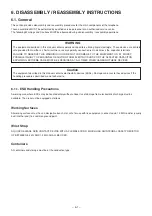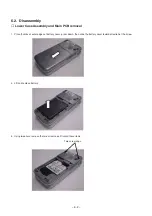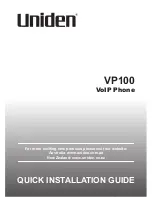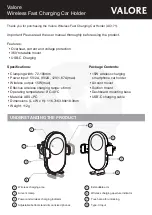
– 7-1 –
7. REPAIR PROCEDURES
7.1. Introduction
This section describes the equipment and software required to test and calibrate the phone.
Calibration Procedures are described in Section 8.
The handset can be connected to a compatible personal computer for electronic adjustment and fault diagnosis. This section
provides a description of the equipment required to perform those tasks.
Prior to testing and adjustment, the unit should first be disassembled, as detailed in Section 6, and then the PCB connected to
the PCB Repair Jig. Fault tracing can be performed on the PCB using suitable test equipment, such as spectrum analysers
and oscilloscopes.
The unit must be tested and calibrated for all frequency bands (900 MHz, 1800 MHz and 1900 MHz).
7.2. Any-Layer Interstitial Via Hole (ALIVH) PCBs
CAUTION
The telephone handset uses an ALIVH PCB assembly, the substrate of which is hydrophilic. To avoid damaging the
ALIVH PCB, the specialist equipment and procedures described below must be employed when replacing suspect or
faulty components.
7.2.1. General Information
To reduce overall size and provide enhanced speech and data performance, an Any-Layer Interstitial Via Hole (ALIVH) PCB is
used in this telephone. ALIVH PCBs are multi-layer boards which have an IVH structure in all inter-layers and can provide an
inter-layer connection immediately under the land of a component. In addition, the PCB has no through holes and any number
of layers can be interconnected.
As the specification and performance characteristics of ALIVH PCBs differ from that of conventional multi-layered boards,
special attention is required when handling and repairing these assemblies.
Moisture Absorbency
The ALIVH PCB is more absorbent than a conventional PCB because of the nature of its material. Its aramid substrate is
hydrophilic, i.e. it absorbs moisture from the air. If, after having absorbed moisture, the ALIVH PCB is submitted to re-flow or
repair process, moisture in the board can suddenly evaporate and cause vapour explosion.
Copper Foil Peel Strength (Land Detachment Resistance)
The ALIVH PCB is slightly less resistant to copper detachment force than conventional boards. Therefore, it is necessary to
ensure that solder is melted sufficiently before a component is removed from the board.
Warping Property
The ALIVH PCB has a smaller Young's Modulus and is therefore more pliant than conventional boards. It is important that the
ALVIH PCB is not bent when component placement is performed.
7.2.2. Repair Procedures
To prevent problems caused by moisture absorption, it will be necessary to perform dehydration of ALIVH PCBs in a suitable
oven or similar heating device prior to repair. The boards should be heated at 85
°
C for a duration of at least ten hours.
The repair should also be performed under the following conditions:
Soldering Iron
The temperature of the tip of the soldering iron should be 350
°
C
±
10
°
C for an application time of five seconds or less.
Removal and re-mounting of components should be performed only once at any component position.
Note: To avoid land detachment, do NOT apply excessive force on the soldering iron when heating the board. Ensure
that the solder has melted sufficiently to allow component removal without damaging the board.
Hot-Air Blower
The blower air temperature should be at:
295
°
C
±
5
°
C for an application time of 120 seconds or less,
or:
395
°
C
±
5
°
C for an application time of 30 seconds or less.
Removal and re-mounting of components should be performed only once at any component position.
















































